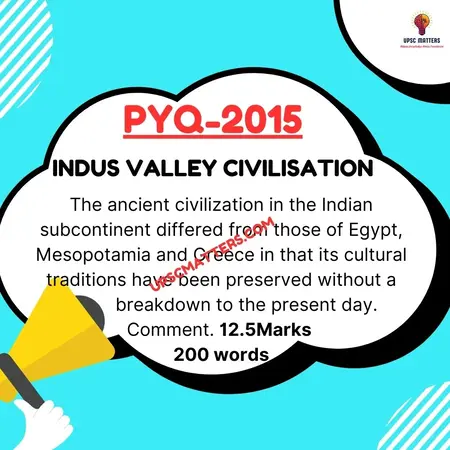The ancient civilization in the Indian subcontinent differed from those of Egypt, Mesopotamia and Greece in that its cultural traditions have been preserved without a breakdown to the present day. Comment.- 12.5 Marks, 200 words.
Approach
-Highlight continuity of Indian civilization (e.g., Hinduism, Sanskrit, rituals).
-Compare with disruptions in Egypt, Mesopotamia, and Greece (e.g., invasions, language loss).
-Emphasize role of geography, oral traditions, and adaptability in preserving Indian culture.
-Conclude with enduring influence on modern Indian society
Introduction
The ancient civilizations in the Indian subcontinent stands out for its remarkable continuity, when compared with ancient civilizations of Egypt, Mesopotamia, and Greece which are often celebrated for their monumental contributions to human history. While the cultural traditions of Egypt, Mesopotamia, and Greece experienced significant disruptions, the Indian subcontinent has preserved its cultural, religious, and social traditions without a major breakdown to the present day.
Reasons for this continuity, supported by recent examples and subheadings have been discussed below-
1. Cultural and Religious Continuity
The ancient Indian civilization, particularly the Indus Valley Civilization and the subsequent Vedic period, laid the foundation for a cultural and religious tradition that has endured for millennia. Unlike the civilizations of Egypt and Mesopotamia, which were largely replaced by foreign cultures, India’s traditions evolved organically.
- Example: The practice of yoga, which originated in ancient India, has not only survived but has also gained global recognition. In 2014, the United Nations declared June 21 as International Yoga Day, highlighting its enduring relevance.
- Example: Festivals like Diwali, Holi, and Navratri have been celebrated for thousands of years and continue to be integral to Indian culture. These festivals are rooted in ancient scriptures like the Vedas and Puranas.
2. Linguistic Continuity
The linguistic traditions of ancient India have also remained intact. Sanskrit, the language of the Vedas, is still studied and revered in India. Unlike the ancient languages of Egypt (Hieroglyphics) and Mesopotamia (Cuneiform), which became extinct, Sanskrit has influenced modern Indian languages like Hindi, Bengali, and Marathi.
- Example: The Indian government has promoted Sanskrit through initiatives like the “Sanskrit Week” celebrated in schools and universities.
- Example: The Bhagavad Gita, written in Sanskrit, remains a widely read and respected text, both in India and globally.
3. Social Structure and Traditions
The ancient Indian social structure, including the caste system and joint family system, has persisted in some form to the present day. While the caste system has evolved and faced criticism, its roots can be traced back to the Vedic period.
- Example: The joint family system, which was prevalent in ancient India, is still practiced in rural areas and among traditional families.
- Example: The concept of “dharma” (duty) and “karma” (action) continues to influence the moral and ethical framework of Indian society.
4. Architectural and Artistic Continuity-
The architectural and artistic traditions of ancient India have been preserved and adapted over time. Temples, sculptures, and paintings from ancient times continue to inspire modern Indian art and architecture.
- Example: The Kumbh Mela, a religious festival that dates back to ancient times, still attracts millions of pilgrims. The construction of temporary cities for the event reflects ancient architectural practices.
- Example: Traditional Indian dance forms like Bharatanatyam and Kathak, which originated thousands of years ago, are still performed and taught today.
5. Philosophical and Intellectual Continuity
Ancient Indian philosophy, including the concepts of Vedanta, Jainism, and Buddhism, has had a lasting impact on Indian thought. Unlike the philosophical traditions of Greece, which were largely replaced by Christianity, Indian philosophy has continued to evolve.
- Example: The teachings of the Upanishads and the works of philosophers like Adi Shankaracharya are still studied and debated in modern India.
- Example: The practice of meditation, rooted in ancient Indian traditions, has gained global popularity as a tool for mental well-being.
6. Economic and Trade Continuity
Agricultural Practices: Many traditional farming techniques mentioned in ancient texts like the Arthashastra are still in use today.
- Example: The promotion of organic farming and Ayurveda-based agriculture in modern India reflects ancient agricultural wisdom.
7. Comparison with Other Civilizations
The civilizations of Egypt, Mesopotamia, and Greece experienced significant disruptions due to invasions, cultural assimilation, and the rise of new religions. In contrast, India’s geographical diversity and cultural resilience allowed it to absorb external influences without losing its core identity.
- Example: The Islamic invasions and the British colonial rule in India led to cultural exchanges but did not completely erase ancient traditions. Instead, they were integrated into the broader cultural fabric.
- Example: The Egyptian civilization, once a dominant force, was largely replaced by Arab culture after the Islamic conquests. Similarly, Mesopotamian culture was absorbed into the Persian and later Islamic empires.
8. Resilience Amidst Invasions and Colonization
Survival of Indigenous Traditions: Unlike Mesopotamian and Egyptian cultures that were largely replaced by external influences, Indian civilization absorbed and assimilated foreign influences without losing its core identity.
- Example: The revival of indigenous knowledge systems in the National Education Policy (NEP) 2020.
Conclusion
The ancient civilization of the Indian subcontinent stands apart from those of Egypt, Mesopotamia, and Greece due to its unparalleled continuity. This continuity is evident in India’s cultural, religious, linguistic, and philosophical traditions, which have been preserved and adapted over thousands of years. While other ancient civilizations experienced significant disruptions, India’s ability to absorb and integrate external influences while retaining its core identity has allowed its cultural traditions to thrive to the present day. The examples of yoga, Sanskrit, traditional festivals, and architectural practices demonstrate the enduring legacy of ancient India, making it a unique and living civilization.
For further insights and a comprehensive analysis, I recommend referring to this article. https://upscmatters.com/indus-valley-civilisation/


1 thought on “The Ancient Civilization in the Indian Subcontinent and Its Continuity: A Unique Legacy”